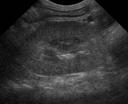Everyone has their own pattern for performing an ultrasound exam. It helps to make sure you look at the major organs for signs of disease. In addition to the kidneys, gastrointestinal tract and pancreas, the ileocolic junction is a very important area to examine in cats. Cats are prone to gastrointestinal neoplasia such as lymphoma and adenocarcinoma. Many of these tumors form at or near the ileocolic junction. In addition, the ileocolic lymph nodes can be enlarged in these and other GI diseases.
The ileocolic junction is formed by the junction of the ileum into the ascending colon at right angles. To find the ileocolic junction, start with the right kidney in a sagittal plane (Image 1). Then, slide the transducer medially. The ileum is thicker than other small intestinal loops with obvious wall layering. With it in a sagittal plane, you should see it terminate into a cross-section of the colon (Image 2). The ascending colon will be larger than the ileum, with thinner walls and dirty shadowing from gas and feces. If you can’t see it right away, rotate the transducer 90 degrees to see if you can recognize it. Another option is to find the transverse colon and follow it caudally to the ascending colon and ileum. Once you find the IC junction, examine the area for any enlarged lymph nodes (Image 3). This should become a regular stop in your ultrasound examination.



Recent Comments